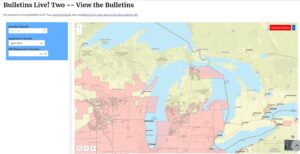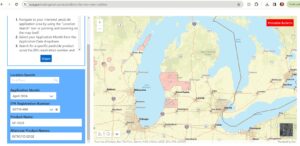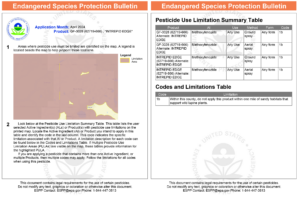Anyone applying agricultural pesticides (certified applicator or not) needs to be aware of changes coming to pesticide labels across the United States.
In an effort to address concerns related to the impact of pesticides on threatened or endangered species and in response to ongoing litigation, the U.S. Environmental Protection Agency has developed an online system called Bulletins Live! Two that determines if additional pesticide use limitations are needed to protect listed species or habitat based on the site location, pesticide product and application month.
The system is intended to avoid blanket use restrictions and instead limit restrictions to geographic and time-specific use patterns that should be avoided to protect endangered species and their habitat.
The Endangered Species Act of 1973 provides a framework to conserve and protect endangered and threatened species and their habitats domestically and abroad. An endangered species is an organism threatened by extinction. Threatened species are likely to become endangered soon. Together, threatened and endangered species are commonly referred to as listed species. The ESA requires listing determinations to consider only scientific and commercial information; economic factors are not allowed to be regarded as part of the listing process. Species may also be removed from the list if they no longer need protection or have a change in status. Michigan currently has 26 known endangered or threatened species.
The EPA ensures that the use of pesticides does not jeopardize listed species or adversely impact their designated critical habitat. If the EPA determines that use of a pesticide may impact listed species, it initiates consultation with U.S. Fish and Wildlife Service or the National Marine Fisheries Service to identify potential negative impacts. The agencies also develop and propose measures to mitigate these negative impacts. Based on the outcomes of this process, the EPA may require additional pesticide use limitations. These limitations are often included in the environmental hazards section of the pesticide label.
However, if it is determined that pesticide use limitations are only needed in specific geographic areas to protect listed species or critical habitat locations, the EPA implements these changes through Endangered Species Protection Bulletins that define pesticide use limitation areas based on the site location, pesticide product and application month. These bulletins are made available via the Bulletins Live! Two system, which allows applicators to check their planned application parameters to determine if any additional pesticide use limitations are required to protect listed species or their habitat. Applicators are only required to consult the Bulletins Live! Two system if the label that came with the pesticide container in their possession directs them to. Bulletins with PULA directives will typically not disclose the listed species or critical habitat the pesticide use limitations are meant to protect.

Applicators are only required to consult the Bulletins Live! Two system if the label that came with the pesticide container in their possession directs them to. Pesticide manufacturers will be adding the Bulletins Live! Two directive to updated labels as required in the coming years, but it will take time for the newer labels to reach the market and applicators to use up existing stocks. Currently, most of the impacted labels with additional pesticide use limitations are agricultural herbicides and insecticides, but additional products are added regularly with the inclusion of fungicides and other pesticides anticipated in the future.
There are use patterns (products, areas and uses) in Michigan that are currently impacted by these new pesticide use limitations and require applicator compliance. Pesticides that require the Bulletins Live! Two system will indicate so on the label, often under the environmental hazards section. The label will direct applicators to visit the map-based system known as Bulletins Live! Two and view the bulletin for the intended application parameters (site location, pesticide product and application month). If a pesticide label directs you to Bulletins Live! Two, you are required to follow the pesticide use limitations found on both the label and on the bulletin generated by Bulletins Live! Two.
To generate a bulletin, you will need the following information:
- Location that you can navigate to manually or enter as an address or coordinates
- Application month and year
- The product EPA registration number that is found on the pesticide label.
The bulletins themselves are simply a document that describes any additional pesticide use limitations based on the proposed application site. It includes a map of the location, the application timing and product.
It is important to note that there may not be any additional specific use limitations based on the application parameters. This could be because EPA has not yet identified if additional pesticide use limitations are needed or if there are no additional geographically specific use limitations based on the use pattern. Though not required, applicators are encouraged to print or save the bulletin along with their pesticide records, even if no additional pesticide use limitations apply.


Compliance with all label directives including using Bulletins Live! Two is mandatory and the applicator’s responsibility. Applicators can generate bulletins up to six months before an application and should do so as far in advance as possible to check for any additional pesticide use limitations that might impact their ability to utilize the pesticide as intended. Ideally, applicators will carefully check the labels of products they are considering before purchase to fully understand any use limitations on their site. Because Bulletins Live! Two will continue to add new pesticides continuously, applicators need to continue to check all product labels carefully for this new directive.
For more information on navigating Bulletins Live! Two, view the EPA tutorial. For more information on the changes related to the Bulletins Live! Two system, visit the Michigan State University Extension Bulletins Live! Two webpage. For more information on how Michigan State University Extension is supporting efforts to conserve Michigan biodiversity, including listed species and critical habitat, visit the Michigan Natural Feature Inventory website.
This work is supported by the Crop Protection and Pest Management Program [grant no 2021-70006-35450] from the USDA National Institute of Food and Agriculture. Any opinions, findings, conclusions, or recommendations expressed in this publication are those of the author(s) and do not necessarily reflect the view of the U.S. Department of Agriculture.
This article was published by Michigan State University Extension.


